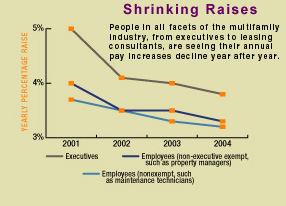Slowing Turnover Even in a “jobless recovery,” retention remains one of the apartment industry’s greatest human resources challenges, particularly at the property level. According to this year’s survey, some of the highest average turnover rates were recorded for key on-site jobs: property managers and leasing consultants. Leasing consultants nearly topped the chart with 70.8 percent yearly turnover.
Such statistics highlight an expensive cost for the multifamily business—the time and money involved in continually recruiting, interviewing, screening, and training new employees, not to mention lost productivity and damaged morale among remaining employees. Perhaps most importantly, departures can damage the crucial relationship between apartment residents and their community staff.
What’s the reason for such a revolving on-site door? A real or perceived lack of career opportunity, according to 48.1 percent of survey respondents.
That’s an alarming figure and one that should lead multifamily human resources executives to assess the effectiveness of their companies’ career development practices and, if lacking, identify how to improve them. Although non-monetary rewards and cash performance incentives together can improve the multifamily industry’s human resources development and retention performance, educational opportunities, mentoring, and other development-oriented programs also play a vital role in keeping and challenging good people.
Turnover is an issue for other service-oriented and real estate-based industries, such as retail, as well. Although comparisons between such industries are not fully analogous to the multifamily arena, it is useful to watch the trends in these similar groups. Comparing multifamily retention levels with those of other industries that share like labor pools and employee skill sets can be very instructive.
If the figures are right though, apartment executives have some work to do. The average total turnover for exempt employees in full-time retail work was 24.5 percent, much lower than multifamily stats. And, according to Jacobs, survey group manager with Watson Wyatt, the average total turnover for nonexempt, full-time retail sector employees was 27.1 percent—a number far below the average total turnover rate of 48.2 percent for nonexempt property management employees during the survey period.
Many apartment companies are paying attention. “Turnover is a top priority” at Concord Management, Ltd., in Maitland, Fla., says Bill Pastor, vice president of human resources at Concord. In an effort to boost retention at Concord, Pastor participates in a weekly meeting of various company representatives, including executives, managers, and property-level staff, to discuss Concord’s latest turnover statistics and develop new approaches to addressing and responding to the reasons why employees leave.
Placing a high premium on human capital has its rewards. “Saying employees are our most valuable asset and living that belief are two very different things,” says Eileen Swensen, president of Tarragon Management, Inc. “We have made a commitment to empower our associates through education, challenges, accountability, rewards and recognition, appropriate compensation and listening. This approach affords us the chance to develop talent, which in turn provides us with the opportunity to promote from within as we grow. “
The approach works. More 30 percent of Tarragon’s current management associates have been promoted.
Such progress didn’t happen without attention and dedication. Swenson says that Tarragon began to “adjust agendas and attitudes” in its effort to hire the best employees—and to keep them. Executive-level commitment and self-evaluation have been key components of this approach. And they are seeing the results. In a performance that would delight an apartment executive, Tarragon has sliced its turnover from 72.9 percent in 2000 to 30.3 percent in 2003.
–Betsy Feigin Befus (ebefus@nmhc.org) is senior legislative analyst at the National Multi Housing Council in Washington, D.C.
